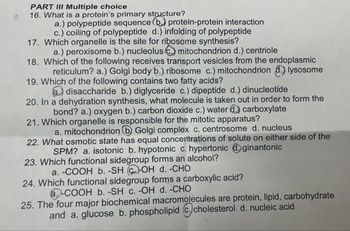
Biochemistry
9th Edition
ISBN: 9781319114671
Author: Lubert Stryer, Jeremy M. Berg, John L. Tymoczko, Gregory J. Gatto Jr.
Publisher: W. H. Freeman
expand_more
expand_more
format_list_bulleted
Question
Write type answer

Transcribed Image Text:PART III Multiple choice
B 16. What is a protein's primary structure?
17.
a.) polypeptide sequence (b) protein-protein interaction
c.) coiling of polypeptide d.) infolding of polypeptide
Which organelle is the site for ribosome synthesis?
a.) peroxisome b.) nucleolus mitochondrion d.) centriole
18. Which of the following receives transport vesicles from the endoplasmic
reticulum? a.) Golgi body b.) ribosome c.) mitochondrion d.) lysosome
19. Which of the following contains two fatty acids?
a disaccharide b.) diglyceride c.) dipeptide d.) dinucleotide
20. In a dehydration synthesis, what molecule is taken out in order to form the
bond? a.) oxygen b.) carbon dioxide c.) water d) carboxylate
21. Which organelle is responsible for the mitotic apparatus?
a. mitochondrion b Golgi complex c. centrosome d. nucleus
22. What osmotic state has equal concentrations of solute on either side of the
SPM? a. isotonic b. hypotonic c. hypertonic @ginantonic
23. Which functional sidegroup forms an alcohol?
a. -COOH b. -SHOH d. -CHO
24. Which functional sidegroup forms a carboxylic acid?
a-COOH b. -SH c. -OH d. -CHO
25. The four major biochemical macromolecules are protein, lipid, carbohydrate
and a. glucose b. phospholipid (c. cholesterol d. nucleic acid
Expert Solution
This question has been solved!
Explore an expertly crafted, step-by-step solution for a thorough understanding of key concepts.
Introduction
VIEW 16. What is a protein's primary structure?
VIEW 17. Which organelle is the site for ribosome synthesis?
VIEW 18. Which of the following receives transport vesicles from the endoplasmic reticulum?
VIEW 19. Which of the following contains two fatty acids?
VIEW 20. In a dehydration synthesis, what molecule is taken out in order to form the bond?
VIEW 21. Which organelle is responsible for the mitotic apparatus?
VIEW 22. What osmotic state has equal concentrations of solute on either side of the SPM?
VIEW Functional groups
VIEW 25. The four major biochemical macromolecules are protein, lipid, carbohydrate and
VIEW Step by stepSolved in 10 steps

Knowledge Booster
Similar questions
- Why is it necessary for pregnant women to strengthen their “pelvic floor”? Please, No copy or paste, thank youarrow_forwardPlease answer asap and type your answer and do not copy from anywhere pleasearrow_forwardACTIVE LEARNING TEMPLATES System Disorder STUDENT NAME _____________________________________ DISORDER/DISEASE PROCESS _______________________________________________________dehydration ___________ ACTIVE LEARNING TEMPLATE: ASSESSMENT SAFETY CONSIDERATIONS PATIENT-CENTERED CARE Alterations in Health (Diagnosis) Pathophysiology Related to Client Problem Health Promotion and Disease Prevention Risk Factors Expected Findings Laboratory Tests Diagnostic Procedures Complications Therapeutic Procedures Interprofessional Care Nursing Care Medications Client Educationarrow_forward
- Hello, I hope you're doing great! I need help with these worksheets. I need to know the function and the cell form(columnar, Cuboidal, and Squamous, and where the nucleus is located(in the center or the edge of the cell). PLEASE NOTE:- I sent this question before, and it says that it is a graded answer, it is not a graded question. I was given this question to help me understand what kind of things might be in my exam Thank you!arrow_forwardI need help getting the right answer for the queshtion typed out pleasearrow_forwardPlease answer fast If you see DAPI stained cells that look like this, suggest what you may be observing.arrow_forward
arrow_back_ios
arrow_forward_ios
Recommended textbooks for you
 BiochemistryBiochemistryISBN:9781319114671Author:Lubert Stryer, Jeremy M. Berg, John L. Tymoczko, Gregory J. Gatto Jr.Publisher:W. H. Freeman
BiochemistryBiochemistryISBN:9781319114671Author:Lubert Stryer, Jeremy M. Berg, John L. Tymoczko, Gregory J. Gatto Jr.Publisher:W. H. Freeman Lehninger Principles of BiochemistryBiochemistryISBN:9781464126116Author:David L. Nelson, Michael M. CoxPublisher:W. H. Freeman
Lehninger Principles of BiochemistryBiochemistryISBN:9781464126116Author:David L. Nelson, Michael M. CoxPublisher:W. H. Freeman Fundamentals of Biochemistry: Life at the Molecul...BiochemistryISBN:9781118918401Author:Donald Voet, Judith G. Voet, Charlotte W. PrattPublisher:WILEY
Fundamentals of Biochemistry: Life at the Molecul...BiochemistryISBN:9781118918401Author:Donald Voet, Judith G. Voet, Charlotte W. PrattPublisher:WILEY BiochemistryBiochemistryISBN:9781305961135Author:Mary K. Campbell, Shawn O. Farrell, Owen M. McDougalPublisher:Cengage Learning
BiochemistryBiochemistryISBN:9781305961135Author:Mary K. Campbell, Shawn O. Farrell, Owen M. McDougalPublisher:Cengage Learning BiochemistryBiochemistryISBN:9781305577206Author:Reginald H. Garrett, Charles M. GrishamPublisher:Cengage Learning
BiochemistryBiochemistryISBN:9781305577206Author:Reginald H. Garrett, Charles M. GrishamPublisher:Cengage Learning Fundamentals of General, Organic, and Biological ...BiochemistryISBN:9780134015187Author:John E. McMurry, David S. Ballantine, Carl A. Hoeger, Virginia E. PetersonPublisher:PEARSON
Fundamentals of General, Organic, and Biological ...BiochemistryISBN:9780134015187Author:John E. McMurry, David S. Ballantine, Carl A. Hoeger, Virginia E. PetersonPublisher:PEARSON

Biochemistry
Biochemistry
ISBN:9781319114671
Author:Lubert Stryer, Jeremy M. Berg, John L. Tymoczko, Gregory J. Gatto Jr.
Publisher:W. H. Freeman

Lehninger Principles of Biochemistry
Biochemistry
ISBN:9781464126116
Author:David L. Nelson, Michael M. Cox
Publisher:W. H. Freeman

Fundamentals of Biochemistry: Life at the Molecul...
Biochemistry
ISBN:9781118918401
Author:Donald Voet, Judith G. Voet, Charlotte W. Pratt
Publisher:WILEY

Biochemistry
Biochemistry
ISBN:9781305961135
Author:Mary K. Campbell, Shawn O. Farrell, Owen M. McDougal
Publisher:Cengage Learning

Biochemistry
Biochemistry
ISBN:9781305577206
Author:Reginald H. Garrett, Charles M. Grisham
Publisher:Cengage Learning

Fundamentals of General, Organic, and Biological ...
Biochemistry
ISBN:9780134015187
Author:John E. McMurry, David S. Ballantine, Carl A. Hoeger, Virginia E. Peterson
Publisher:PEARSON